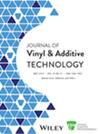The effect of solvent, graft density, and actuators-lubricants on the evaluation of friction and viscosity of slip additives
Abstract
This work carried out a mesoscopic scale numerical modeling of a polymeric brush system constituted of a heterogeneous mixture of two slip additives erucamide (Eru) and stearyl erucamide (sEru). The polymeric brushes are grafted onto two parallel plates moving under a stationary laminar Couette-type flow in non-equilibrium conditions, to evaluate the coefficient of friction (Cof) and the viscosity system. The Cof and viscosity were obtained as a function of the graft concentration, solvent and brush composition, and the fixed number of Eru actuators-lubricants. It was found that the 2:1 ratio (Eru:sEru) seems to be the most effective in reducing the Cof in all cases, but specifically for the 80%-air/20%-humidity solvent composition, the Cof reaches a value of 0.33 keeping the number of Eru actuators-lubricants fixed at 400. Under the same conditions, viscosity reduction is favored at higher graft concentrations, reaching values of 0.8 and 0.7 respectively. The results indicate that by increasing the amount of Eru actuators-lubricants, the Cof decreases significantly with a higher concentration of grafts. This could be crucial to optimizing friction properties, impacting various applications such as the plastics and packaging industry, agricultural film production, lubricant, and textile coatings, where these slip additives are commonly used.
Highlights
- Solvent composition influences the optimization of the Cof and viscosity.
- Eru actuators-lubricants act as lubricating rollers in the solvent.
- The mixture of the brushes reduces the Cof between the surfaces.
- The molecular mechanism of slip additives is predicted at a mesoscopic scale.




 求助内容:
求助内容: 应助结果提醒方式:
应助结果提醒方式:


